A Mid-Autumn Moon Leaves Evening, Planets Dance, Jupiter Peaks and the Demon Fades While the Bull Shoots Stars, and the Owl Hoots!
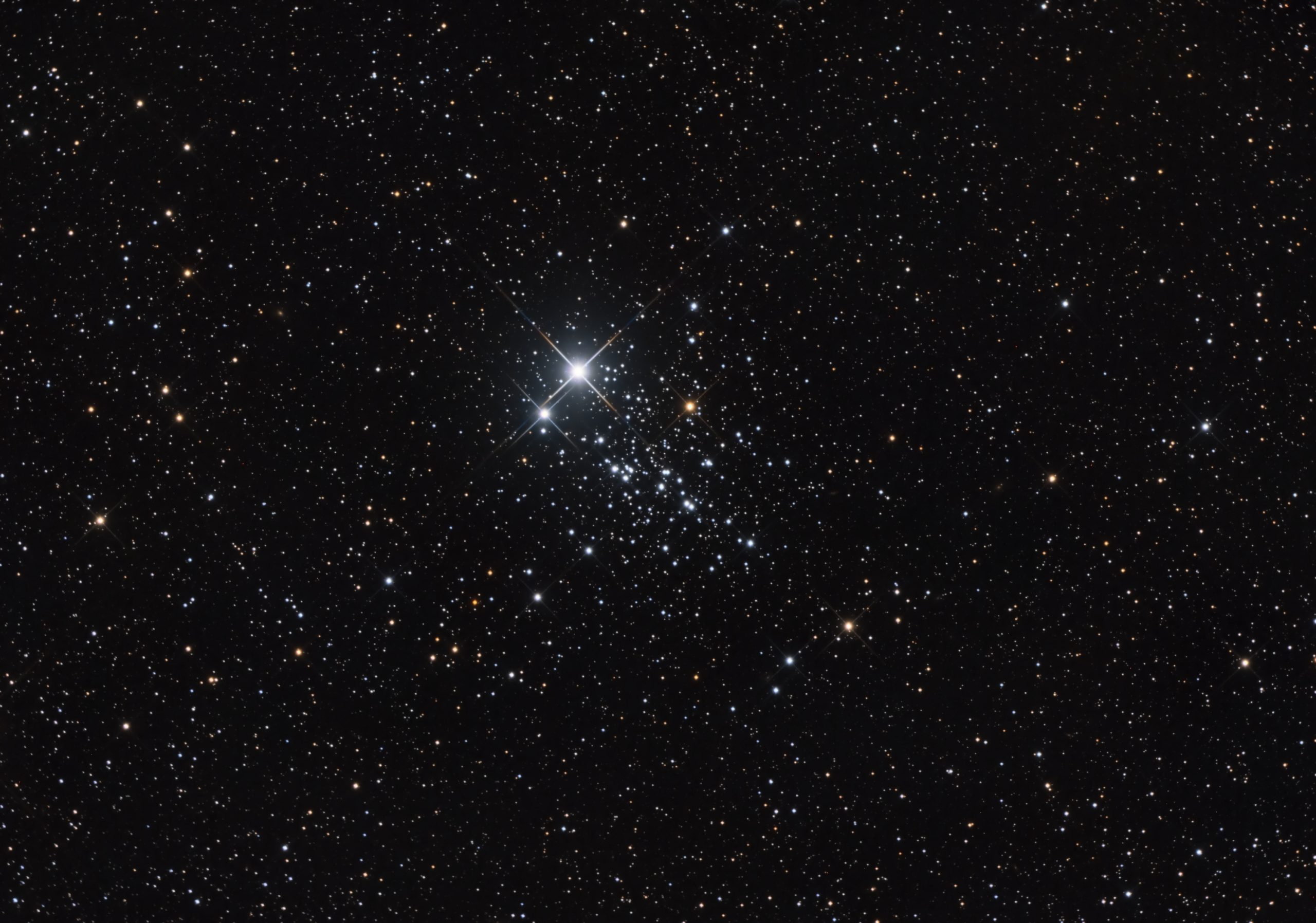
NGC 457, better known as the Owl Cluster, ET Cluster, and Dragonfly Cluster, was imaged by “Astrodoc” Ron Brecher of Guelph, Ontario. The bright stars are the eyes. The body and feet extend down to the right. Squint to see the upswept, curving chains of stars for the wings.This image covers a finger’s width of the sky l-r. View Ron’s other images at www.astrodoc.ca
Hello, Spooky Stargazers!
Here are your Astronomy Skylights for the week of November 5th, 2023 by Chris Vaughan. Feel free to pass this along to your friends and send me your comments, questions, and suggested topics. You can also follow me on Twitter as @astrogeoguy! Unless otherwise noted, all times are expressed in Eastern Time. To subscribe to these emails please click this MailChimp link.
If you’d like me to bring my Digital Starlab portable inflatable planetarium to your school or other daytime or evening event, or deliver a session online, contact me through AstroGeo.ca, and we’ll tour the Universe, or the Earth’s interior, together! I’m proud of my book with John A. Read entitled 110 Things to See With a Telescope. It’s a guide to viewing the deep sky objects in the Messier List – for both beginners and seasoned astronomers. DM me to order a signed copy!
It’s going to be a busy week in the sky! The bright moon will gradually leave evening, allowing more Taurids meteors and the spooky Owl Cluster to be seen. Meanwhile, Jupiter will reach opposition for 2023, Algol will be dimmed on Saturday evening, mid-Autumn will arrive, and the clocks will fall back. Read on for your Skylights!
Halloween Marks Mid-Autumn
Halloween, or All Hallows’ Eve, has been pinned to the date of October 31 every year. It actually originated from Samhain, a festival observed by the ancient Celts and Druids that was held to mark the end of harvest season and the beginning of winter weather. The Pagan Thanksgiving, perhaps? Astronomically speaking, samhain is one of the four cross-quarter days, the seasonal midpoints that occur halfway between each solstice and equinox.
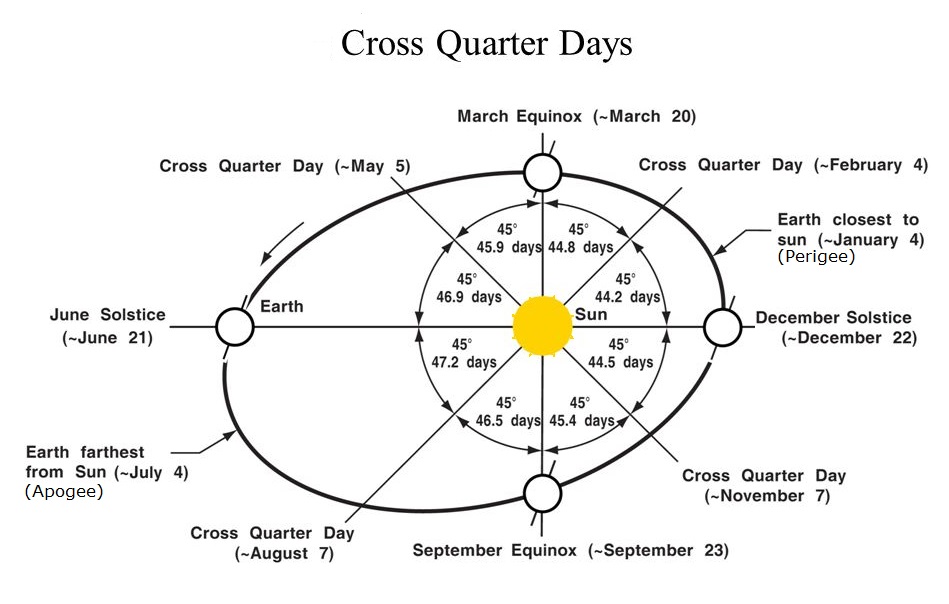
In modern times, observers of Samhain celebrate it on November 1 – but the true mid-point of autumn will occur next week at around noon Eastern time on November 7, 2023. At that time, the ecliptic longitude of the sun will be 225° – extremely close to the double star Zubenelgenubi in Libra (the Scales). The other three cross-quarter days are Groundhog Day (or Imbolc) on February 3, May Day (Beltane) on May 5, and Lughnasath or Lammas on August 7.
You can’t merely divide our 365.25-day year into four 91.3-day seasons and then count half that many days to reach the cross-quarters. Planets with elliptical orbits move faster when they are closer to the sun and slower when they are farther away. Since Earth is moving slower at aphelion in July, summers in the Northern Hemisphere are about five days longer than winters!
Falling Back
For jurisdictions that employ Daylight Saving Time (or DST, for short), clocks should be set back by one hour at 2 am local time on Sunday morning, November 5 – or before you go to sleep on Saturday night. I’ll share some more interesting information about DST next week.
Meteor Shower Update
Meteor shower season continues! The Southern Taurids meteor shower, which runs worldwide from September 28 to December 2 annually, will reach its maximum rate of about 5 meteors per hour next Sunday evening, November 5. Some meteors will appear as the sky darkens on Sunday, but the best viewing time in the Americas will be around midnight, before the bright, waning crescent moon starts to climb the eastern sky. Southern Taurids meteors can appear anywhere in the sky, but they will be travelling away from a point in western Taurus near Jupiter. The long-lasting, weak shower is the first of two consecutive showers derived from debris dropped by the passage of periodic Comet 2P/Encke. The larger-than-average grain sizes of the comet’s debris often produce colorful fireballs.

The second shower, the Northern Taurids, will peak a week from now when there will be less moonlight. Its meteors will also be travelling away from Jupiter. Jupiter will not shine near the Taurids radiants on future years.
The Mysterious Demon Star
The star Algol in the constellation of Perseus (the Hero) represents the glowing eye of Medusa from Greek mythology. Also designated Beta Persei, it is among the most accessible variable stars for skywatchers. During a ten-hour period that repeats like clockwork every 2 days, 20 hours, and 49 minutes, Algol dims noticeably and re-brightens by about a third when a fainter companion star with an orbit nearly edge-on to Earth crosses in front of its much brighter primary, reducing the total light output we perceive. Astronomers call that arrangement an eclipsing binary star.
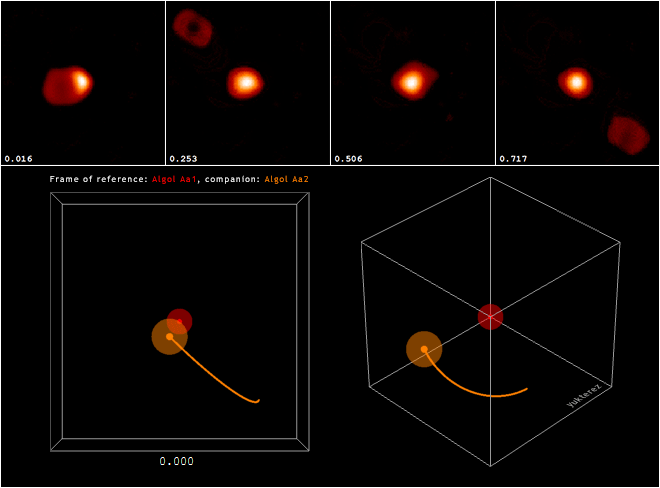
Algol normally shines at magnitude 2.1, similar to the nearby star Almach (aka Gamma Andromedae). But while fully dimmed, Algol’s brightness of magnitude 3.4 is almost identical to Rho Persei (or Gorgonea Tertia or ρ Per), the star sitting 2.25 degrees to Algol’s south. On Saturday evening, November 4 at 6:56 pm EDT or 22:56 Greenwich Mean Time, Algol will fade to its minimum brightness. At that time it will be located in the lower part of the northeastern sky. Five hours later the star will return to full intensity from a perch nearly overhead. Observers in more westerly time zones can see the latter stages of the brightening. (But anyone can look up their own dimming times at https://skyandtelescope.org/observing/the-minima-of-algol/.)
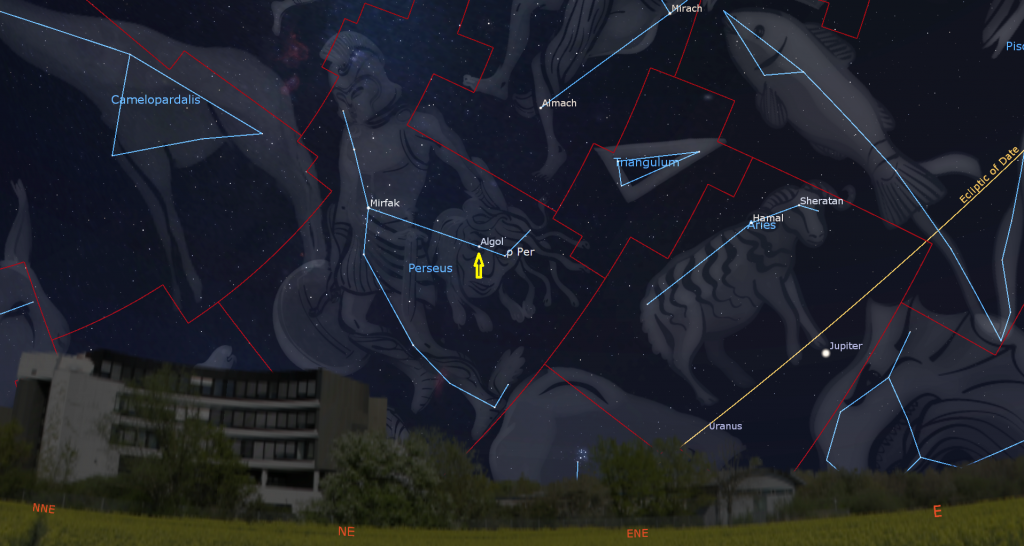
The Moon
The bright moon will flood the evening sky worldwide with light for much of this week (and the late-night sky all week) as it wanes from this weekend’s full moon toward third quarter.
Today (Sunday) our natural night-light will rise shortly after sunset and follow bright Jupiter across the sky all night long. Though it will be surrounded by the stars of Aries (the Ram), they will not be apparent against the moon’s glare – nor will the bright little Pleiades Star Cluster that will be positioned a palm’s width to the moon’s left (or celestial northeast). Binoculars will show you the Pleiades. The planet Uranus will also be located near the moon – but I wouldn’t bother looking for it this week.
On Monday and Tuesday, the waning gibbous moon will journey through Taurus (the Bull), dangling from the bull’s higher horn for Halloween. Tuesday night will be a good opportunity to see the rugged terrain on the western rim of Mare Crisium because the curved, pole-to-pole terminator will be falling across that dark oval “sea”. While you have the binoculars or telescope set up, scan below Crisium to see the subtle wrinkles snaking across Mare Fecunditatis, which will also be half in shadow. Also, after 24 hours of its orbital motion, the moon will be positioned to the lower left of the Pleiades.

The moon will spend Wednesday and Thursday with Gemini’s twins, then venture into Cancer (the Crab) on Friday night. Night owls on Saturday night or early-birds on Sunday morning can use the half-illuminated moon to find the big open star cluster called the Beehive or Presepe, (or Messier 44 or NGC 2632, by astronomers). After midnight on Saturday, the cluster, which is more than twice the size of the moon, will be sparkling faintly several finger widths to the upper right of the moon (or 5 degrees to its celestial WSW). To see the “bees” better, tuck the moon out of sight on the left side of your binoculars’ field of view. By the time the sky begins to brighten on Sunday morning, the cluster will be more than a palm’s width to the moon’s right.
The moon will complete three quarters of its orbit around Earth, measured from the previous new moon, on Sunday, November 5 at 3:37 am EST, 12:37 am PST, or 08:37 Greenwich Mean Time. The 10 or so dark, moonless evenings that follow this phase are the best ones for observing fainter deep sky targets every month. I love the sight of the golden-tinted third quarter moon rising in the east as I am driving home from a night of observing – like an old friend.

Since it will be rising late on the coming weekend, it will shine above bright Venus before dawn. The duo will meet in spectacular fashion on November 9!
The Planets
Those of us living at mid-northern latitudes certainly don’t have to work too hard to see planets nowadays! Almost as soon as the sun sets around 6 pm local time, bright Jupiter can be spotted above the eastern horizon between the houses and trees. And Venus is blazing away in the east before sunrise every morning.
Once the sky darkens a little each evening, Saturn’s more modest jewel will draw your attention in the southeastern sky. The ringed planet won’t be very high initially. By 9 pm it will gain a little more altitude, then sink westward to set during the wee hours. Saturn is within the borders of Aquarius (the Water-bearer), but most of his stars are to Saturn’s left (or celestial east).
On Saturday night, November 4, Saturn’s westward motion through Aquarius will slow to a stop as it completes a retrograde loop that it began in June. Retrograde loops occur when Earth, on a faster orbit closer to the sun, passes more distant solar system objects “on the inside track”, making them appear to move backwards across the stars for a while. Saturn’s loop covered about a palm’s width or 6 degrees of the sky. After that night, Saturn will gradually ramp up to its regular eastward prograde motion.
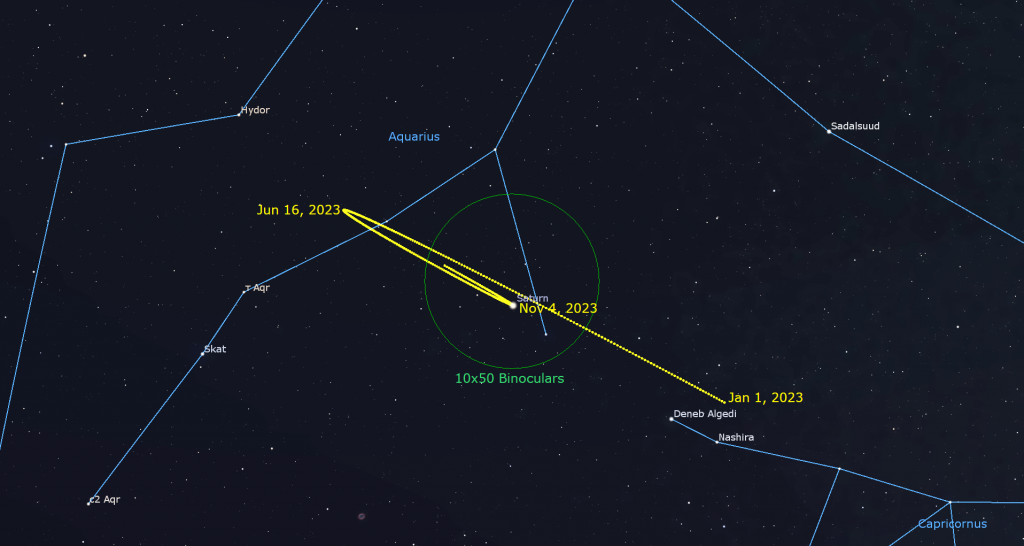
Any size, style, or brand of telescope will show Saturn’s beautiful rings. If your optics are of good quality and the air isn’t too turbulent, try to see the Cassini Division, a narrow gap that separates the large outer A Ring from the large inner B Ring. I wrote more about the rings last week here. Good binoculars can hint at the shape of Saturn’s rings, too.
From here on Earth, Saturn’s axial tilt of 26.7° lets us see the top of its ring plane, and allows its brighter moons to array themselves above, below, and alongside the planet. Saturn’s largest and brightest moon Titan never wanders more than five times the width of Saturn’s rings from the planet. The much fainter moon named Iapetus can stray up to twelve times the ring width during its 80-day orbit of Saturn. The next brightest moons Rhea, Dione, Tethys, Enceladus, and Mimas all stay within one ring-width of Saturn.
During this week, Titan will migrate counter-clockwise around Saturn, moving from the left of Saturn (celestial east) tonight to the right of the planet (celestial west) next Sunday night. (Remember that your telescope will probably flip the view around.) The rest of the moons will be tiny specks. You may be surprised at how many of them you can see through your telescope if you look closely.
The ice giant planet Neptune, currently about 730 times fainter than Saturn, follows the ringed planet across the sky each night. This week it will be lurking 2.4 fist diameters to Saturn’s left, or 24° to its celestial northeast. The diurnal rotation of the sky – the way things tilt as they cross from east to west – will cause Neptune to be increasingly higher than Saturn as the hours pass. Magnitude 7.8 Neptune is visible in backyard telescopes, especially between dusk and 2 am local time, when the blue planet is highest. Good binoculars can show Neptune, too – if your sky is very dark.
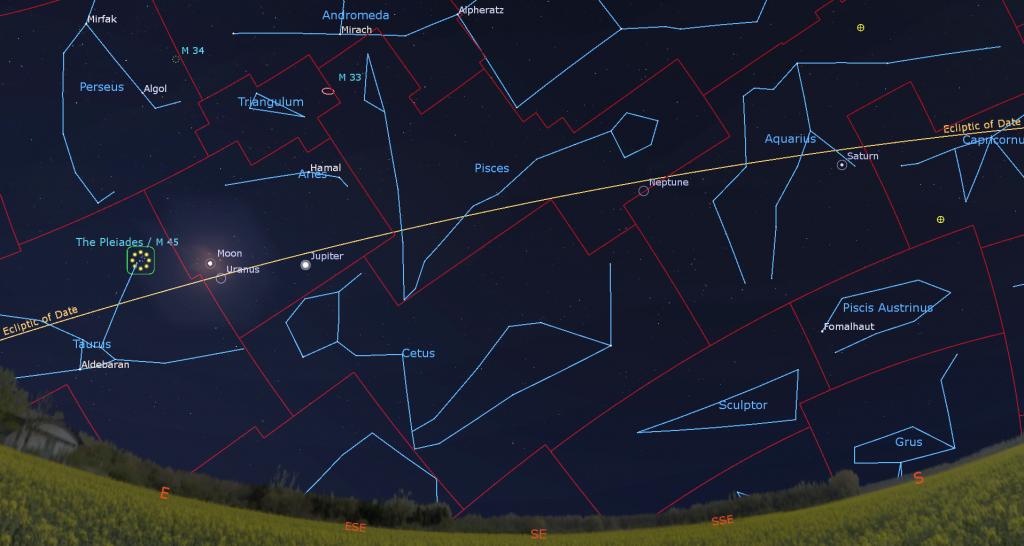
Jupiter will reach opposition and peak visibility for this year on Thursday night in the Americas. At opposition, planets rise in the east at sunset and cross the sky all night long before setting in the west at sunrise. Jupiter will also be at a minimum distance from Earth for this year of 595.8 million km or 33.1 light-minutes, boosting its brilliance to magnitude -2.91. Its best telescope-viewing time will start by 8 pm. The two brightest stars of Aries (the Ram), named Hamal and Sheratan, have been shining a generous fist’s diameter above the giant planet this year. Next year, Jupiter’s 12-year orbit will place it into Taurus (the Bull). Keep an eye out for Jupiter gleaming above the western horizon around sunrise each morning.
Binoculars will show you Jupiter’s four Galilean moons in a line beside the planet. Named Io, Europa, Ganymede, and Callisto in order of their orbital distance from Jupiter, those moons complete orbits of the planet every 1.7, 3.6, 7.2, and 16.7 days, respectively. If you see fewer than four moons, then one or more of them is crossing in front of or behind Jupiter, or hiding in Jupiter’s dark shadow – or two of the moons are very close together or occulting one another.
A small, but decent quality telescope can show you Jupiter’s dark belts and light zones, which are aligned parallel to its equator. With a better grade of optics, Jupiter’s Great Red Spot, a cyclonic storm that has raged for hundreds of years, becomes visible for several hours when it crosses the planet every 2nd or 3rd night. For observers in the Americas, the GRS will cross Jupiter’s disk in mid-evening Eastern Time tonight (Sunday), Tuesday, Friday, and next Sunday night. It’ll appear around midnight on Tuesday, Friday, and next Sunday morning, and before dawn on Monday, Thursday, and Saturday morning. If you have any coloured filters or nebula filters for your telescope, try enhancing the spot with them.
From time to time, the small, round, black shadows cast by Jupiter’s Galilean moons become visible in amateur telescopes when they cross (or transit) the planet’s disk. On Friday morning, November 3, Io’s small shadow will cross Jupiter’s equatorial region from 5:30 to 7:37 am EDT (or 09:30 to 11:37 GMT), but Jupiter will set in the Eastern time zone before Io’s shadow has finished crossing. Europa’s shadow will venture across Jupiter’s southern latitudes, on Friday evening, November 3 from 9:17 to 11:35 pm EDT (or 00:17 to 03:35 GMT on November 4). Europa itself will pop into view when it moves off Jupiter at the end of the shadow transit. Io’s shadow will cross again on Saturday night, November 4, this time with the Great Red Spot, from 11:58 pm to 1:07 am EDT (or 03:58 to 05:07 GMT on November 4). Io itself will appear at the end of the shadow transit. (These times may vary by a few minutes, and other time zones of the world will have their own crossings.)

Just as Neptune is following Saturn in evening, the planet Uranus is following Jupiter across the overnight sky. This week the blue-green ice giant planet will be positioned a generous fist’s diameter to Jupiter’s lower left (or 11° to the celestial east), just on the Aries side of its border with Taurus. The diurnal rotation of the sky will lift Uranus higher than Jupiter after 1 am local time. The bright little Pleiades star cluster will be located a shorter distance to Uranus’ left. Magnitude 5.6 Uranus is visible in both binoculars and small telescopes when a bright moon isn’t nearby, but the bright moon will pay Uranus a visit tonight (Sunday).
Uranus is a treat to see in a telescope. The best time for looking at Uranus’ small blue-green disk will start around 9 pm local time (from Tuesday onwards). This year, a pair of medium-bright stars named Botein and Al Butain IV (or Sigma and Zeta Arietis) are shining two finger widths above Uranus every evening. Since they are easy to see in binoculars, they can act as your guides.
On Thursday, the eastward prograde motion of the large, main belt asteroid Vesta through the background stars of Gemini (the Twins) will slow to a stop. Tonight magnitude 6.7 Vesta will be relatively easy to find in binoculars and backyard telescopes in the eastern sky between the feet of the twins. Search midway between the stars Tejat Posterior and Alhena, both of which are visible with your unaided eyes or binoculars. From now until early February the asteroid will travel to the west of those stars, toward Orion’s upraised club.
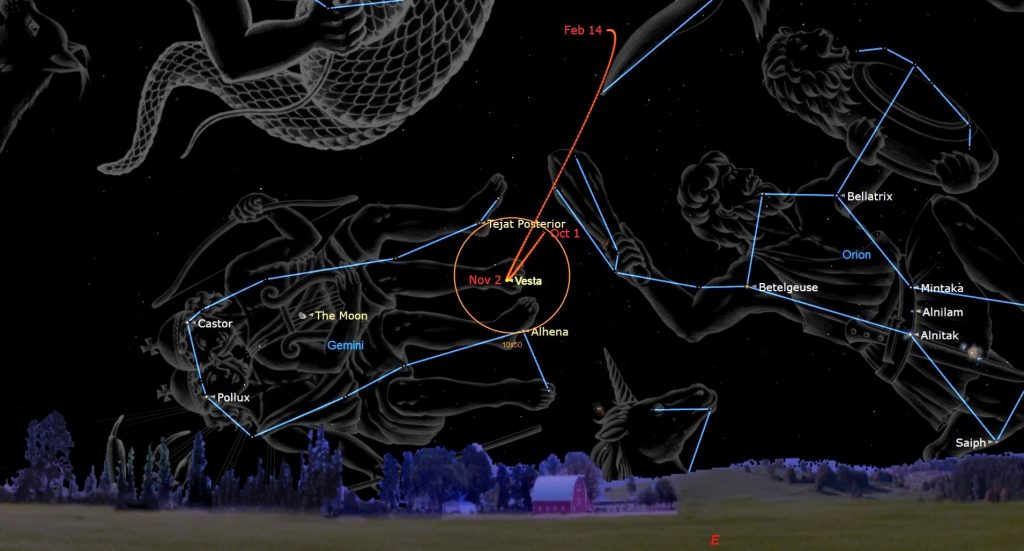
Venus and Jupiter will continue to gleam on opposite sides of the pre-dawn sky this week. If you head outside on a clear morning around 6 am local time, Venus and Jupiter will each be positioned at about the same height in the sky, though Jupiter will be descending in the west while Venus is lifted higher in the east by Earth’s rotation. The bright stars of the winter constellations will shine between them in the southern sky.
Venus recently reached its greatest separation from the morning sun. Now it will gradually shift lower each morning. This week, the very bright, magnitude -4.4 planet will be shining in the eastern sky from the time it rises at about 4 am local time until sunrise hides it. Viewed through a telescope, Venus will show a waxing, slightly gibbous disk spanning 22 arc-seconds.
Mercury has entered the post-sunset sky, but it’s too low to be easily seen from mid-northern locales. Mars is too near to the sun to be seen.
Halloween Treats for Binoculars and Backyard Telescopes
One of my favorite spooky objects can be seen in binoculars or any backyard telescope. It’s an open star cluster designated NGC 457 in W-shaped Cassiopeia (the Queen), but I prefer its common names – the Owl Cluster, ET Cluster, or Dragonfly Cluster. Cassiopeia is located high in the northeastern sky on autumn evenings. The star at the middle of the W is Navi or Gamma Cas. The next bright star below Navi is Ruchbah.
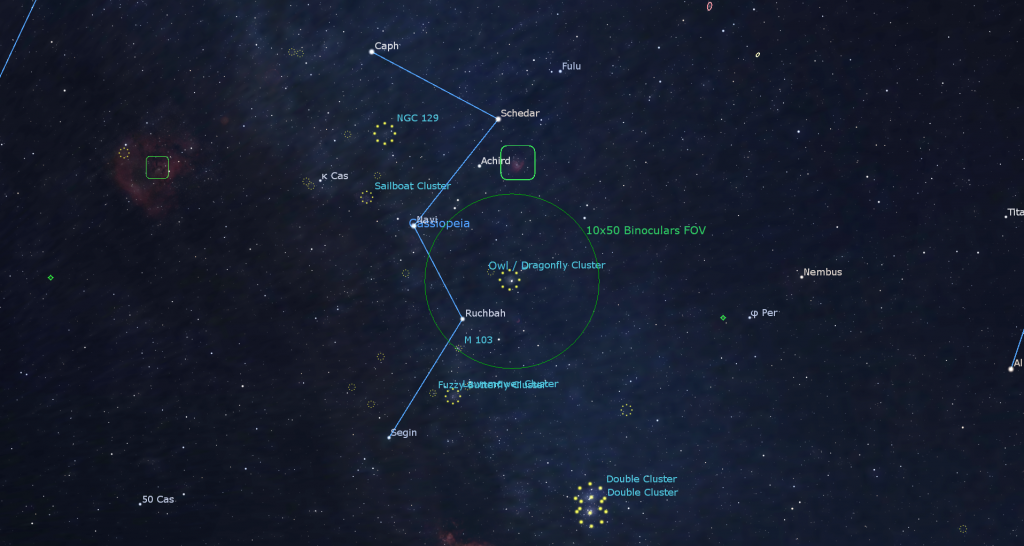
The Owl Cluster consists of two prominent, brighter yellow stars that form the eyes, a sprinkling of dimmer stars that form the owl’s body and feet, and two curved chains of stars that look like upswept wings. Be aware that the critter is positioned with its head pointing away from Cassiopeia. Locate the owl by taking the stars Navi and Ruchbah and making them the two vertices of a right-angle triangle. The cluster sits at the third vertex, where the 90 degree corner is. It’s about four finger widths above Ruchbah – as if the queen is bouncing a baby owl on her knee! Binoculars will show you a tiny bright patch dominated by those yellow eyes. A telescope will see her take flight!
Cassiopeia is surrounded by many big, bright star clusters. Scan around the W on the next clear night and see what treats you can scare up!
Keep your eyes on the skies! I love getting questions and requests. Send me some!